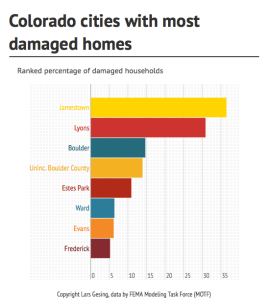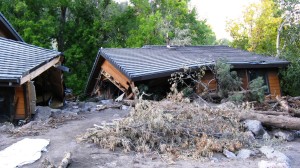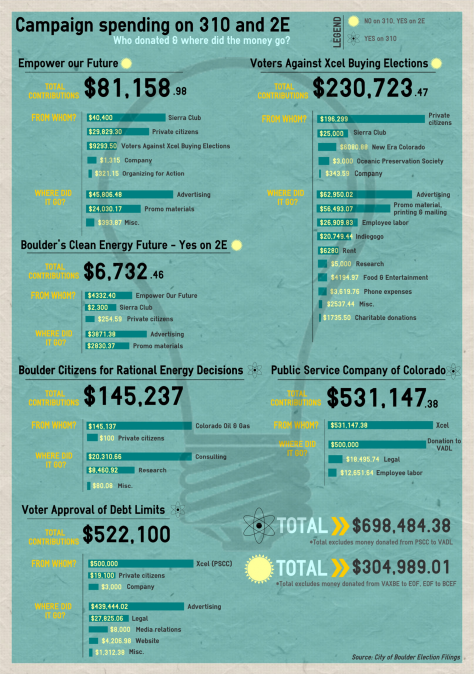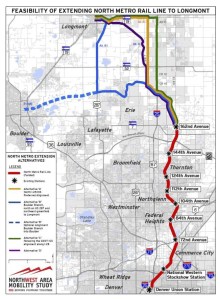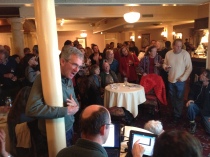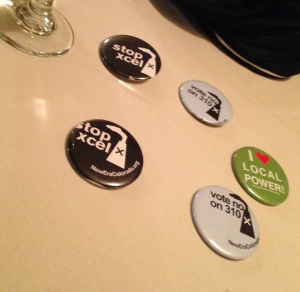By Kendall Brunette
This was the big one — the event everyone knew could happen, but everyone hoped wouldn’t.
“When you’re in this line of work, you live for these kinds of incidents – you train for it,” said Steve Silbermann, the communications supervisor with the Boulder County Sheriff’s Office. “You don’t live for it because you hope for harm on people, land or property, but this is what we do for a living.”
On the evening of Sept. 11, Silbermann left work at the county dispatch center. It was raining outside, but never did it cross his mind that a historic storm was soon to follow.
But shortly after leaving, the dispatch center became inundated with 911 calls. People were trapped in cars, stranded on roofs. Most were simply confused. They couldn’t fully grasp the severity of the situation.
Around 9 p.m., Silbermann returned to the dispatch center, where his his division chief turned him away, telling him to go home, get some rest and prepare for what would be a long week to come.
Eighteen-hour workdays became the norm. The sleep center within the county communications building remained full as employees worked tirelessly throughout the day and into the night.
Silbermann and his colleagues worked with police and fire departments, and EMS and rescue teams to coordinate emergency protocols and address 911 calls. Rescuers couldn’t respond to several calls simply because there was no access to people.
“The roads [were] being washed away,” Silbermann said.
September brought more than just flooding rain to Boulder County. It brought challenges that the county never expected to face — problems brought about by a historic storm, but exacerbated by previous wildfire and technological communication issues. Silbermann and colleagues were prepared to handle many of those challenges, but they never envisioned a flood of this magnitude.
Looking back, however, Silbermann is proud of what the county accomplished and, with a few tweaks in the system, feels that Boulder County is well-prepared for a similar catastrophe.
Fourmile Canyon Fire
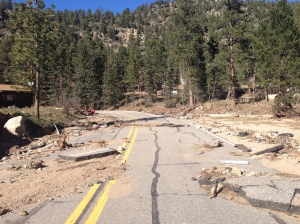
The remnants of a road through the town of Glen Haven, Colo. after September’s flood.
Photo by Kendall Brunette
In 2010 the Fourmile Canyon fire burned more than 6,000 acres and 169 homes. The devastating fire stripped the land of all vegetation. The fire left scorched, barren soils prone to flooding.
“When you have a dense forest with undergrowth, you have plants and things to trap moisture and rain,” said Kari Bowen, meteorologist at the National Weather Service office in Boulder during an interview with LiveScience. “But when it’s gone, you have nothing to catch it.”
“The fire also makes the ground almost hydrophobic, or water-repelling, and these effects can last 10 to 15 years,” she added.
Exactly three years after the fire, torrential rains consumed Boulder’s rivers, streams, valleys, hills and mountains. As predicted, dry soil within the burn area did little to absorb the rain and floods ensued.
Over the last three years, hydrologists studied the area in an effort to better understand the increased post-fire flood risk. According to Silbermann, Boulder County spent millions of dollars to help recover land within the Fourmile burn. A process known as aerial mulching drops hay mixed with grass seeds from helicopters to increase water absorption on burned soils and re-vegetate the land. The county hoped the mulching would speed up post-fire recovery and reduce the flood risk.
Boulder’s Office of Emergency Management (OEM) used the data from hydrologists to educate people living in the burn area, as well as the general public about what could happen in the event of severe weather. While public education was concentrated on those people living within the burn, Silbermann believes that people everywhere were well-prepared for the flood.
“When we talk about these flood risks that existed after the Fourmile fire, we always imagined it was going to be isolated to the burn area – that those would be the only people severely affected by such a storm,” Silbermann said. “We never imagined that it was going to be a massive up-slope storm that affected the whole Front Range, let alone just Boulder County. That was the kicker.”
Air Evacuations
Over the next few days, more than 2,000 people were evacuated by Chinooks, Blackhawks and various other air supports. Silbermann’s sources claim that the 2013 Colorado Flood was the second largest air evacuation in U.S. history. The only other natural disaster that used comparable air support was Hurricane Katrina.
Silbermann described the scene at the Boulder Municipal Airport – the incident command post during the flooding.
“It was kind of like when you’re at the Boulder Transit Center and RTD buses are flowing in and out – it was like that with helicopters,” Silbermann said. “It was Chinooks landing and a bunch of people getting out, looking like they had come from DIA because they had their pets in pet carriers, kids in hand and rollaway luggage and duffels.”
Dispatch Communications
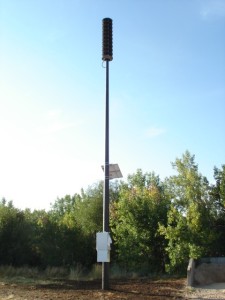
Emergency siren in the town of Louisville, Colo.
Photo courtesy Dave Sittner
During the flooding, the Boulder County Dispatch Center relied primarily on their emergency siren system and Everbridge – an interactive communication and mass notification system to relay warnings to the public. Everbridge sends emergency notifications via text message, phone calls and emails to people who opt-in to the system.
The Boulder County Fire Department designates zones throughout the county that are loaded into a mapping software program. In the event of an emergency, county dispatchers can log into the program and send a specific message to certain zones. For example, the Fourmile Burn area comprises a particular geographic zone. Dispatchers send an array of pre-scripted messages, as well as improvised live warnings through Everbridge.
Four times throughout the year, landlines throughout the county are uploaded into Everbridge. Messages go out automatically to these lines. As cell phone popularity surpasses landline use, the need for people to enroll their cellular devices into Everbridge becomes important. OEM has increased public education to make people aware of their option to opt-in to alerts.
During September’s flood, county dispatch sent over 80 emergency notifications through Everbridge. The content of the notifications ranged from evacuation notices to water contamination warnings. OEM maintained a variety of social media outlets including, Twitter, Facebook and their website to keep the public updated.
Rural Communication
For people living in rural parts of the county, however, Everbridge and social media are not reliable methods of communication. Internet and cellular service can be spotty at best in areas like Boulder Canyon, Fourmile Canyon, Nederland and Lyons. While Everbridge was still able to send messages through household landlines, the “door-to-door knock and talks,” as Silbermann called them, played a larger part in rural emergency notifications. Police and fire department personnel conducted home visits that were critical is notifying rural residents of flood danger.
“Yes, communication technologies are invaluable, but that doesn’t compare to a cop or firefighter walking up to your door and saying, get out!” Silbermann said. “That saved lives – we’ll never know how many.”
Emergency Sirens
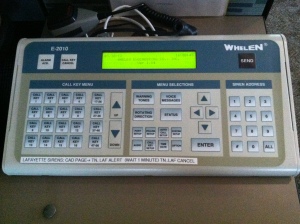
One of the encoders used to remotely initiate the county’s emergency sirens.
Photo courtesy Dave Sittner
Dave Sittner, communications technician with the Boulder County Sheriff’s Office, said there are 23 emergency sirens throughout the county. (View siren map here)
One of the questions Sittner frequently hears is why aren’t there sirens at certain locations. For example, why isn’t there a siren in the Fourmile burn zone?
According to Sittner, there is no “magic bullet formula” determining siren placement. Generally, officials try to place sirens in places of greatest efficiency – places where the sirens will be heard by the greatest number of people.
Many rural communities throughout Boulder County don’t have sirens simply because of debilitating costs. Sittner said that each siren costs approximately $25,000. The only rural community with sirens within the county is Lyons.
Dan Barber, deputy director at Boulder OEM, was the county sheriff sergeant assigned to Lyons. During his time in this position, he urged town officials to spend the money to install new warning sirens. Eventually, the town paid heed to Barber’s concerns and installed two sirens in 2008. In Barber’s mind, it wasn’t if, but when the big flood was going to happen and in September Lyons residents were thankful for Barber’s persistent efforts.
Sittner and colleagues heard several reports that Lyons sirens saved countless lives during the flooding.
After-Action Meetings
In the three months since the flood, local fire and police department, county dispatchers and EMS have and continue to host meetings to capture what went well and what needs to be improved upon, in terms of flood communications.
Silbermann said that, “Overall, this event went really well for emergency services.”
Most of the challenges that the individual agencies faced were directly related to access.
“We had 911 calls where we said, I’m sorry, we can’t get to you – a lot of them,” Silbermann said.
The reality is that the flooding cut off a lot of people from help and emergency services. One improvement being discussed in the after-action meetings is to map out more pre-determined zones for Everbridge messaging – Lyons specifically.
“What we’ve done for the Fourmile burn planning, we’re expanding countywide,” Silbermann noted.
Some residents complained that they were unable to hear the siren messaging. Sittner explained that the sirens are not meant to be heard indoors. The hope is that the sirens will alert people who are outside and face the most immediate danger. The Everbridge system complements the sirens by sending alerts to those indoors. During September’s flood, heavy rain created ambient noise that interfered with the sirens – an issue that they county claims they don’t have any control over.
Cry Wolf Syndrome
There has been a lot of concern over the years that Everbridge notifications and siren warnings may be used too liberally. When a storm system settles over areas like the Fourmile burn, dispatchers alert residents of possible flood risks. When these threats are unanswered, residents become desensitized to the notifications – a situation Silbermann refers to as “cry wolf syndrome.”
September’s events, however, opened people’s eyes to what could happen and how important the emergency communications system really is.
“There’s no way to put a number on it – there’s no way to have a statistic of it, but we have done so much research and public education to notify our citizens of what could happen in the event of a flood over the last three years since the fire, that I truly believed we saved a lot of lives,” Silbermann concluded.
